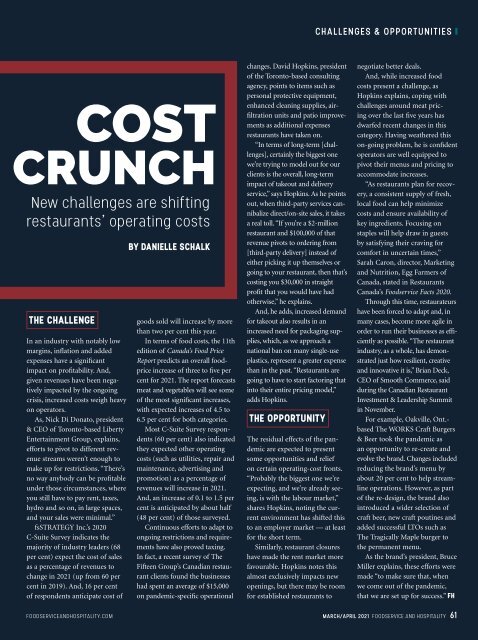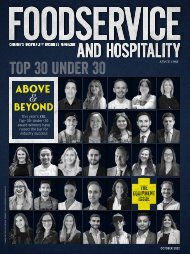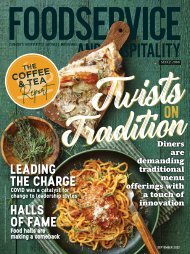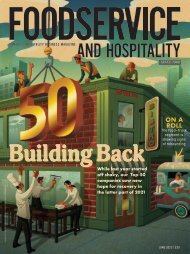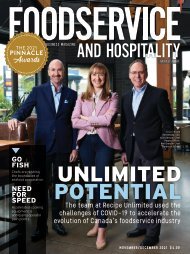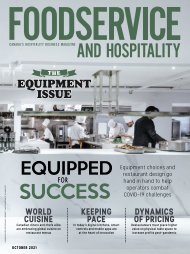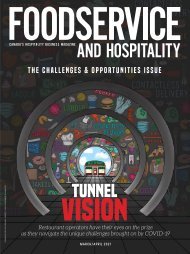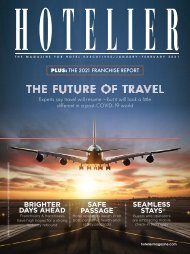March/April (Revised)
You also want an ePaper? Increase the reach of your titles
YUMPU automatically turns print PDFs into web optimized ePapers that Google loves.
CHALLENGES & OPPORTUNITIES<br />
THE CHALLENGE<br />
COST<br />
CRUNCH<br />
New challenges are shifting<br />
restaurants’ operating costs<br />
In an industry with notably low<br />
margins, inflation and added<br />
expenses have a significant<br />
impact on profitability. And,<br />
given revenues have been negatively<br />
impacted by the ongoing<br />
crisis, increased costs weigh heavy<br />
on operators.<br />
As, Nick Di Donato, president<br />
& CEO of Toronto-based Liberty<br />
Entertainment Group, explains,<br />
efforts to pivot to different revenue<br />
streams weren’t enough to<br />
make up for restrictions. “There’s<br />
no way anybody can be profitable<br />
under those circumstances, where<br />
you still have to pay rent, taxes,<br />
hydro and so on, in large spaces,<br />
and your sales were minimal.”<br />
fsSTRATEGY Inc.’s 2020<br />
C-Suite Survey indicates the<br />
majority of industry leaders (68<br />
per cent) expect the cost of sales<br />
as a percentage of revenues to<br />
change in 2021 (up from 60 per<br />
cent in 2019). And, 16 per cent<br />
of respondents anticipate cost of<br />
BY DANIELLE SCHALK<br />
goods sold will increase by more<br />
than two per cent this year.<br />
In terms of food costs, the 11th<br />
edition of Canada’s Food Price<br />
Report predicts an overall foodprice<br />
increase of three to five per<br />
cent for 2021. The report forecasts<br />
meat and vegetables will see some<br />
of the most significant increases,<br />
with expected increases of 4.5 to<br />
6.5 per cent for both categories.<br />
Most C-Suite Survey respondents<br />
(60 per cent) also indicated<br />
they expected other operating<br />
costs (such as utilities, repair and<br />
maintenance, advertising and<br />
promotion) as a percentage of<br />
revenues will increase in 2021.<br />
And, an increase of 0.1 to 1.5 per<br />
cent is anticipated by about half<br />
(48 per cent) of those surveyed.<br />
Continuous efforts to adapt to<br />
ongoing restrictions and requirements<br />
have also proved taxing.<br />
In fact, a recent survey of The<br />
Fifteen Group’s Canadian restaurant<br />
clients found the businesses<br />
had spent an average of $15,000<br />
on pandemic-specific operational<br />
changes. David Hopkins, president<br />
of the Toronto-based consulting<br />
agency, points to items such as<br />
personal protective equipment,<br />
enhanced cleaning supplies, airfiltration<br />
units and patio improvements<br />
as additional expenses<br />
restaurants have taken on.<br />
“In terms of long-term [challenges],<br />
certainly the biggest one<br />
we’re trying to model out for our<br />
clients is the overall, long-term<br />
impact of takeout and delivery<br />
service,” says Hopkins. As he points<br />
out, when third-party services cannibalize<br />
direct/on-site sales, it takes<br />
a real toll. “If you’re a $2-million<br />
restaurant and $100,000 of that<br />
revenue pivots to ordering from<br />
[third-party delivery] instead of<br />
either picking it up themselves or<br />
going to your restaurant, then that’s<br />
costing you $30,000 in straight<br />
profit that you would have had<br />
otherwise,” he explains.<br />
And, he adds, increased demand<br />
for takeout also results in an<br />
increased need for packaging supplies,<br />
which, as we approach a<br />
national ban on many single-use<br />
plastics, represent a greater expense<br />
than in the past. “Restaurants are<br />
going to have to start factoring that<br />
into their entire pricing model,”<br />
adds Hopkins.<br />
THE OPPORTUNITY<br />
The residual effects of the pandemic<br />
are expected to present<br />
some opportunities and relief<br />
on certain operating-cost fronts.<br />
“Probably the biggest one we’re<br />
expecting, and we’re already seeing,<br />
is with the labour market,”<br />
shares Hopkins, noting the current<br />
environment has shifted this<br />
to an employer market — at least<br />
for the short term.<br />
Similarly, restaurant closures<br />
have made the rent market more<br />
favourable. Hopkins notes this<br />
almost exclusively impacts new<br />
openings, but there may be room<br />
for established restaurants to<br />
negotiate better deals.<br />
And, while increased food<br />
costs present a challenge, as<br />
Hopkins explains, coping with<br />
challenges around meat pricing<br />
over the last five years has<br />
dwarfed recent changes in this<br />
category. Having weathered this<br />
on-going problem, he is confident<br />
operators are well equipped to<br />
pivot their menus and pricing to<br />
accommodate increases.<br />
“As restaurants plan for recovery,<br />
a consistent supply of fresh,<br />
local food can help minimize<br />
costs and ensure availability of<br />
key ingredients. Focusing on<br />
staples will help draw in guests<br />
by satisfying their craving for<br />
comfort in uncertain times,”<br />
Sarah Caron, director, Marketing<br />
and Nutrition, Egg Farmers of<br />
Canada, stated in Restaurants<br />
Canada’s Foodservice Facts 2020.<br />
Through this time, restaurateurs<br />
have been forced to adapt and, in<br />
many cases, become more agile in<br />
order to run their businesses as efficiently<br />
as possible. “The restaurant<br />
industry, as a whole, has demonstrated<br />
just how resilient, creative<br />
and innovative it is,” Brian Deck,<br />
CEO of Smooth Commerce, said<br />
during the Canadian Restaurant<br />
Investment & Leadership Summit<br />
in November.<br />
For example, Oakville, Ont.-<br />
based The WORKS Craft Burgers<br />
& Beer took the pandemic as<br />
an opportunity to re-create and<br />
evolve the brand. Changes included<br />
reducing the brand’s menu by<br />
about 20 per cent to help streamline<br />
operations. However, as part<br />
of the re-design, the brand also<br />
introduced a wider selection of<br />
craft beer, new craft poutines and<br />
added successful LTOs such as<br />
The Tragically Maple burger to<br />
the permanent menu.<br />
As the brand’s president, Bruce<br />
Miller explains, these efforts were<br />
made “to make sure that, when<br />
we come out of the pandemic,<br />
that we are set up for success.” FH<br />
FOODSERVICEANDHOSPITALITY.COM<br />
MARCH/APRIL 2021 FOODSERVICE AND HOSPITALITY 61


